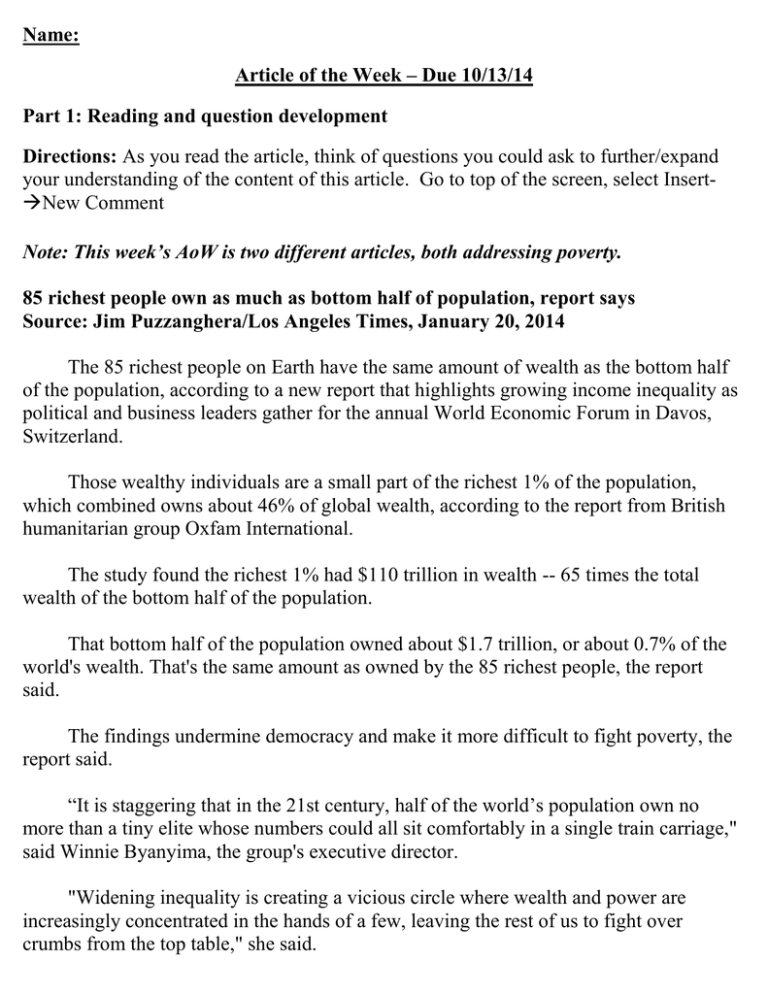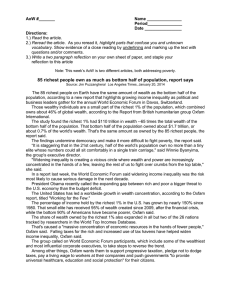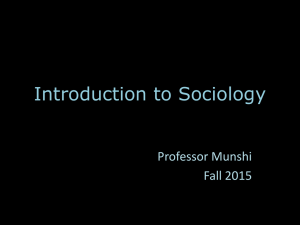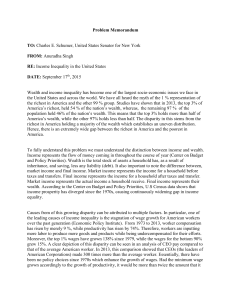Article of the Week – Due 10/13/14 Part 1: Reading and question
advertisement

Name: Article of the Week – Due 10/13/14 Part 1: Reading and question development Directions: As you read the article, think of questions you could ask to further/expand your understanding of the content of this article. Go to top of the screen, select InsertNew Comment Note: This week’s AoW is two different articles, both addressing poverty. 85 richest people own as much as bottom half of population, report says Source: Jim Puzzanghera/Los Angeles Times, January 20, 2014 The 85 richest people on Earth have the same amount of wealth as the bottom half of the population, according to a new report that highlights growing income inequality as political and business leaders gather for the annual World Economic Forum in Davos, Switzerland. Those wealthy individuals are a small part of the richest 1% of the population, which combined owns about 46% of global wealth, according to the report from British humanitarian group Oxfam International. The study found the richest 1% had $110 trillion in wealth -- 65 times the total wealth of the bottom half of the population. That bottom half of the population owned about $1.7 trillion, or about 0.7% of the world's wealth. That's the same amount as owned by the 85 richest people, the report said. The findings undermine democracy and make it more difficult to fight poverty, the report said. “It is staggering that in the 21st century, half of the world’s population own no more than a tiny elite whose numbers could all sit comfortably in a single train carriage," said Winnie Byanyima, the group's executive director. "Widening inequality is creating a vicious circle where wealth and power are increasingly concentrated in the hands of a few, leaving the rest of us to fight over crumbs from the top table," she said. In a report last week, the World Economic Forum said widening income inequality was the risk most likely to cause serious damage in the next decade. President Obama recently called the expanding gap between rich and poor a bigger threat to the U.S. economy than the budget deficit. The United States has led a worldwide growth in wealth concentration, according to the Oxfam report, titled "Working for the Few." The percentage of income held by the richest 1% in the U.S. has grown by nearly 150% since 1980. That small elite has received 95% of wealth created since 2009, after the financial crisis, while the bottom 90% of Americans have become poorer, Oxfam said. The share of wealth owned by the richest 1% also expanded in all but two of the 26 nations tracked by researchers in the World Top Incomes Database. That's caused a "massive concentration of economic resources in the hands of fewer people," Oxfam said. Falling taxes for the rich and increased use of tax havens have helped widen income inequality, Oxfam said. The group called on World Economic Forum participants, which include some of the wealthiest and most influential corporate executives, to take steps to reverse the trend. Among other things, Oxfam wants them to support progressive taxation, pledge not to dodge taxes, pay a living wage to workers at their companies and push governments "to provide universal healthcare, education and social protection" for their citizens. Study: No harder to climb economic ladder Source: Paul Wiseman, AP Business Writer/ USA Today/ January 26, 2014 WASHINGTON (AP) — Young Americans from low-income families are as likely to move into the ranks of the affluent today as those born in the 1970s, according to a report by several top academic experts on inequality. The study, published this week by the National Bureau of Economic Research, runs counter to the widespread belief that a widening gap between rich and poor has made it harder to climb the economic ladder. Democratic and Republican lawmakers alike have expressed alarm over what had been seen as diminishing opportunities for economic advancement through hard work and ingenuity. Instead, the study found that 9% of children born in 1986 to the poorest 20% of households were likely to climb into the top 20% — little-changed from 8.4% for such children born in 1971. "Absolutely, we were surprised" by the results, says Harvard University economist Nathaniel Hendren. He is one of the report's authors along with Harvard's Raj Chetty, Emmanuel Saez and Patrick Kline of the University of California, Berkeley, and Nicholas Turner of the Treasury Department. Worries have been growing across the political spectrum about an expanding divide between America's rich and the rest: The top 1% of Americans accounted for 22.5% of income earned in the United States in 2012. That is one of the highest figures since the Roaring '20s and up from a low 8.9% in 1976, according to a database maintained by Saez. But the fact the top 1% are pulling away has had little effect on the ability of those in the bottom fifth to rise to the top fifth, the study found. The findings are open to different interpretations: They could suggest that government programs to help the poor have made little headway in increasing economic opportunity. Or they could suggest that economic advancement would have become harder without such programs. "My concern is that there may be less mobility in the future," former White House economic adviser Alan Krueger said by email. The cost of a college education, for instance, is increasingly difficult for low- and middle-income families to afford. Hendren emphasizes that it's still harder to move from poverty to affluence in the United States than in most other wealthy countries. In a 2012 study of 22 countries, economist Miles Corak of the University of Ottawa found that the United States ranked 15th for social mobility. Among wealthy countries. Only Italy and the Britain ranked lower. "In some sense, how could it have gotten worse?" Hendren said. "It's not like we're losing the American Dream. We never really had it." Part 2: Reading for Meaning Statements Directions: The purpose of this page is to hone your ability to gather textual evidence to support or refute a statement and to focus your reading on some key points in the article. For each statement below, highlight whether the text agrees or disagrees with it, and, in the space provided, share quoted, textual evidence to support your agreement or disagreement. Agree? Statements yes 1. Wealth is distributed evenly around the globe. no yes no yes no 2. The growing income gap creates even more hurdles for the poor to climb the economic ladder. 3. Poor Americans have limited ability to climb the economic ladder. Your Evidence (cite page and paragraph; briefly explain) Example: Part 3: Write a 150+ word reflection using one of the prompts below: • Share your thoughts about the income gap. What can be done to close the gap? • The first article lists two possible causes for the income gap (falling taxes for the rich and tax havens). What are other possible causes? Research and share other causes. • The second article illustrates how hard it is to climb out of poverty. What can you do as a student to ensure that in the future you won’t be oppressed by this gap? • Select any passage and respond to it. Reflection Self-Editing Checklist I've read through my response, stopping and correcting anything that sounds wordy, awkward, or redundant. I have led into and smoothly blended at least one quotation from the article using a signal phrase (ex. According to the article…). I have used logical, appropriate transitions in my response. My paragraph ends with a logical concluding sentence which sums things up. My response is at least 200+ words in length. It may sound simple, but I've made sure to capitalize the first word in each sentence. Sentences are separated by appropriate punctuation. NO RUN-ONS. Article of the Week Rubric Directions 4 Student follows little directions and leaves out parts of the assignment. Student does not properly reflect on the article. 7 Student follows all of the directions but leaves out part of the assignment. Student reflects on the article by using some textual evidence, but does not explain the relevance of the evidence presented. Student does not show interaction with the content of the article, posing no questions. Student asks 2 moderately difficult questions to show interaction with the content of the article. Reflection Thoughtful Reading/Question Development 10 Student follows all directions and completes all parts of the assignment. Student reflects on the article using mature thinking. Student discusses details of the article, uses textual evidence to support their thinking. Textual evidence is also explained to demonstrate its support for student thinking. Student asks 4 complex and difficult questions to show interaction with the content of the text.







